NavSource Online: Submarine Photo Archive
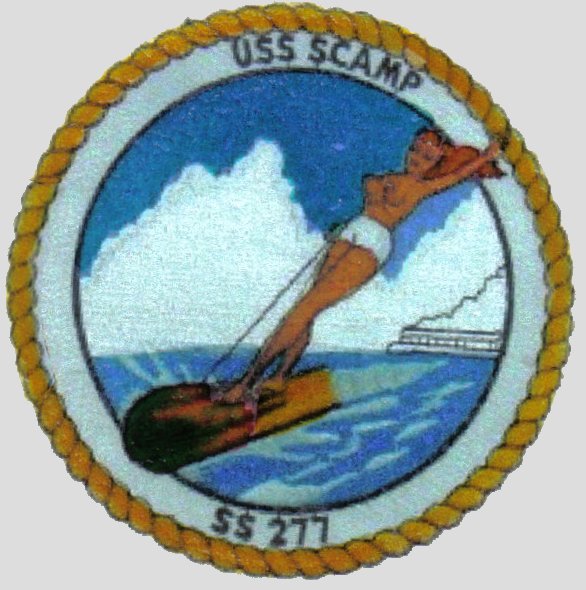
Contributed by Jack Treutle
Scamp (SS-277)

![]()
![]()
![]()
![]()
Gato Class Submarine: Laid down, 6 March 1942, at Portsmouth Navy Yard, N.H.; Launched, 20 July 1942; Commissioned USS Scamp (SS-277), 18 September 1942; Sunk on 8th patrol by depth charge south of Tokyo Bay, 11 November 1944, all hands lost; Struck from the Naval Register, 28 April 1945. Scamp received seven battle stars for World War II service. Specifications: Displacement, Surfaced: 1,526 t., Submerged: 2,410 t.; Length 311' 8"; Beam 27' 4"; Draft 15' 3"; Speed, Surfaced 20.25 kts, Submerged 8.75 kts; Complement 6 Officers 54 Enlisted; Operating Depth, 300 ft; Submerged Endurance, 48 hrs at 2 kts; Patrol Endurance 75 days; Cruising Range, 11,000 miles surfaced at 10 kts; Armament, ten 21" torpedo tubes, six forward, four aft, 24 torpedoes, one 3"/50 deck gun, two .50 cal. machine guns, two .30 cal. machine guns; Propulsion, diesel electric reduction gear with four Fairbanks Morse main generator diesel engines, HP 5400, Fuel Capacity, 94,400 gals., four General Electric main motors, HP 2740, two 126-cell main storage batteries, twin propellers.
| Click On Image For Full Size | Size | Image Description | Source | |
|---|---|---|---|---|
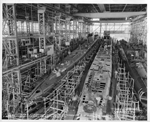 | 2.40k | Original Caption: "Naval Yard Portsmouth, NH. US Submarines Scamp (SS-277), Scorpion (SS-278), and Steelhead (SS-280) under construction in building ways. Stern views looking ford from after catwalk, 7 July 1942. Directly to the left of the Scamp, there is apparently an empty way. However, if you look closely enough, you can just barely see a small section of Balao (SS-285). She filled the way vacated by Sawfish (SS-276) on 23 June 1942. Over on the far left is Snook (SS-279). You can see her conning tower and covered wagon ribs and some portions of her bow. The numbering system for the ways at Portsmouth was quite odd at the time. They were out of numerical sequence. From left to right, they are Ways #2, 4, 3, 1A, & 1. The construction shed was widened in 1941 and two ways were added. Way #1A was crammed in between the others in 1942 and Scorpion was the first to be built on it. | Photo i.d. courtesy of Ric Hedman, John Hummel, David Johnston (USN, retired) & Robert Morgan. US National Archives photo # 19LCM 757-42, from National Archives |
|
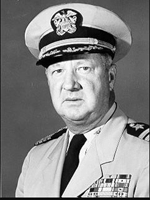 0827715 | 1.51k | The Scamp (SS-277) was sponsored by Miss Katherine Eugenia McKee. Miss Katherine E. McKee, Lt Walter Ousey Wed Here In Colorful Naval Ceremony NAVY BRIDE Is Mrs. Walter Miller Ousey, the former Miss Katherine Eugenia McKee, after her wedding in St. John's church Saturday at 5 pm. She wa given in marriage by her father, Capt. Andrew I. McKee, USN, planning officer at the navy yard. She and her husband Lieutenant (J.G.) in the naval reserve, will live in New London, Conn., after a short wedding trip. |
Photo courtesy of findagrave.com & The Portsmouth Herald, 1 March 1943, Page 17. Text via Newspapers.com | |
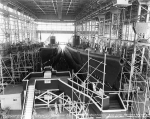 |
319k | Scamp (SS-277), on left & Scorpion (SS-278) at right, dual launching ceremony on 20 July 1942, at Portsmouth Navy Yard,N.H. The book "Portsmouth-Built Submarines of the Portsmouth Naval Shipyard" states that this shiphouse contained five ways at the time. The boat on the left of the Scamp should be the Snook (SS-279), on ways 2, which would be launched 26 days from now, 15 August 1942. |
Photo i.d. courtesy of Darryl L. Baker., David Decrevel, Ric Hedman, John Hummel & David Johnston. USN photo courtesy of Scott Koen & ussnewyork.com. |
|
 |
233k | Scamp (SS-277), going down the ways, 20 July 1942, at Portsmouth Navy Yard, N.H. | USN photo courtesy of Scott Koen & ussnewyork.com. | |
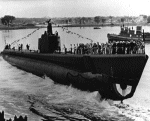 |
100k | With a supportive tug in the wings waiting for her to finish going down the ways, the Scamp (SS-277) slides into the Piscataqua River, 20 July 1942, at Portsmouth Navy Yard, N.H. | USN photo . | |
 |
16k | Commemorative post mark on the occasion of the Scamp's (SS-277) launching, 20 July 1942, at Portsmouth Navy Yard,N.H. | Courtesy of Jack Treutle (of blessed memory). | |
 |
204k | The seaplane carrier Kamikawa Maru, off the coast of China, 1940, with "Alfs" aft and "Daves" forward. She is armed with 4.7" (120mm) AA guns fore and aft, and twin 25mm AA guns in the bridge wings. She has no catapult. Sunk 28 April 1943 North of New Ireland (01 degrees 00' S, 150 degrees 18' E) by the submarine Scamp (SS-277). | Photo courtesy Royal Netherlands Navy via Robert Hurst. | |
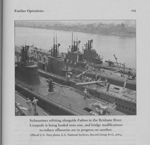 |
640k | Photo caption reads: Submarines refitting alongside Fulton (AS-11) in the Brisbane River. A torpedo is being loaded onto one, and bridge modifications to reduce silhouette are in progress on another. Boat #1: Grouper (SS-214), Boat #2: Peto (SS-265), Boat #3: Scamp (SS-277), Boat #4: Albacore (SS-218), Boat #5: Drum (SS-228), 4-7 June, 1943. EB plan 2053-29, and BuShips plan 388778. Its a general outboard arrangement for SS-214-221 and SS-253-254. It shows very plainly that boats from SS-214 onwards only had the one small boat locker. Grouper only had the one small boat locker offset to port, but she carried the bulge to starboard as if she had one there too, only she didn't! The plan very clearly shows the bulge to starboard for Grouper, but then states, "DECKLINE FOR SS-214 ONLY." Grouper being modified with her bridge being cut down after her May 29 return from patrol with a high fairwater as in the US Subs Down Under photo, which would explain the whitish look to her bridge face; it was probably primer or wet paint. The bulge to starboard that I originally thought indicated either Gato (SS-212) or Greenling (SS-213) is there, but there just isn't any locker beneath it! Why EB built Grouper like this is anyone's guess. Perhaps when the change order came, construction on Grouper was already too far ahead to stop and re-contour the deck casing? EB wasn't known for deviating from the plans lightly, so perhaps this was the best the Navy could get out of them? They then went to the single locker and no starboard bulge of any kind starting with Growler (SS-215). This might explain why the Manitowoc boats had the single locker, too, since their contract was to build copies of Growler herself, portholes in the bridge face notwithstanding. EB initially resisted pressure from the Navy to alter the plans, citing concerns about delays in production if they did. What they were really worried about was making a profit, each little change cost more and ate into their profit margin. This attitude was somewhat understandable, as EB is a civilian company and they existed to make a profit for their shareholders. However, EB's intransigence got so bad that the Bureau of Ships had to threaten the company with making them build the boats to the Government plans supplied by Portsmouth, wiping out their design capability, which would have put them in a very bad spot commercially after the war. EB backed off when they realized how serious the Bureau was. They took on a whole new attitude and their resistance to change quickly evaporated. What you are seeing with Grouper is an outgrowth of this situation. As part of an attempt to eliminate what the Bureau thought was "frivolous" peacetime equipment on the boats, an order was issued on 10 May 1942 to eliminate the motorboat. This was the official order that legitimized a practice that was already going on in the fleet. Many of the submarines beached the motorboat(s) between patrols as it became clear that they were just not needed anymore. Grouper was probably built with the original capacity of having two boats, as was the original intent for the Gato class. But she may have only gotten one boat when she was finished. Albacore's patrol report backs up her being Boat #4. It reads, in part, "Major items accomplished during refit - alteration of bridge superstructure for mounting additional 20 mm gun." This was for her refit between 27 May and 10 June, 1943, so the dates connect up nicely with the photo. Either way, the dates look solid, and the activity in the photo looks like a June, 1943, photo. Peto would depart on patrol on June 13th, so the boxes on her foredeck are probably supplies being loaded up. |
Photo i.d. & text courtesy of Robert Morgan & David Johnston Photo courtesy of Robert Morgan courtesy of US Subs Down Under, 1942-1945 by David Jones & Peter Nunan. |
|
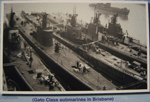 |
391k | The boats shown are all Gato's. Boat #1: Grouper (SS-214), Boat #2: Peto (SS-265), Boat #3: Scamp (SS-277), Boat #4: Albacore (SS-218), Boat #5: Drum (SS-228), 4-7 June, 1943. |
Photo i.d. & text courtesy of David Johnston Photo courtesy of Gerhard Mueller-Debus via Gary Priolo. |
|
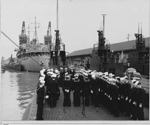 | 1.40k | Citation from Admiral Carpender aboard the Guardfish receiving their submarine combat insignia on 18 August 1943. The boats in the background are: Peto (SS-265) in the middle. Interesting that she still has the high bridge forward. She would depart on 9/1/43, so unless the tender did a quick cut down, she would have departed on patrol in September still with a high bridge. Even if they did cut it down before she departed, its interesting that she still had it as late as August. I had no idea they were splotching the periscopes that early, a great detail for modelers. Scamp (SS-277) to the right. Assuming the August 18 date is correct, that would match up. Scamp departed on patrol on September 2nd, so she would have been there. If the boat to her port is a high bridged type (hard to tell, but from the sailor peeking out of the dead light, maybe), then she would be Peto, who was likely the only high bridge type there, and probably the very last one. She would depart on September 2nd. Others in port at that time included Albacore (SS-218), Stingray (SS-186), Grouper (SS-214) and likely Gato (SS-212). All departed Brisbane between August 23rd and September 6th. Grouper is to the left in the background moored with the Fulton (AS-11). The boat to her starboard whose extreme stern is probably Tuna (SS-203). She had left for patrol before the awards ceremony date, but a friendly fire incident with an RAAF bird forced her back into Brisbane for repairs, so she had reentered port and didnít leave again until August 21st, 1943. She had the aft torpedo tube shutters as-built like the other Tambors, and like the mystery boat. Itís hard to see and faint but the mystery boat appears to have the degaussing circuit on her stern. So did Tuna (http://www.navsource.org/archives/08/0820306.jpg), and at that precise place and time, too. | Majority text i.d. courtesy of Robert Morgan, with input from David Johnston (USN, retired) & John Hummel, USN (Retired). US National Archives photo # 80-G-394390 & 80-G-394401 from National Archives and Records Administration (NARA), College Park, Maryland, courtesy of Sean Hert. |
|
 |
76k | From Brisbane, Scamp (SS-277) departed on her third war patrol on 22 June 1943. She patrolled a scouting line off the Solomon Islands and north to the Bismarck Sea. She passed the Shortland Islands on 14 July and, on 27 July, encountered an enemy convoy. During her approach, a destroyer passed over her and dropped two depth charges some distance from her. Scamp continued her approach and loosed a spread of six torpedoes at a Japanese tanker. She scored a hit but had to dive in order to escape the escorts. When she surfaced, a little over an hour later, all enemy shipping was out of sight. Continuing her patrol into the Bismarck Islands, Scamp patrolled to the southeast of Steffen Strait, between New Ireland and New Hanover. At 17:54, still on 27 July, she sighted a submarine, which launched a torpedo at Scamp. Scamp went ahead full and levelled off at 22 feet (6.7 m), letting the torpedo pass above her. Less than ten minutes later, she returned to periscope depth to engage her adversary. At 1812, she launched four torpedoes and the Japanese boat erupted in a tremendous explosion. At the time, it was believed that the loser of that duel was the Japanese submarine I-24. Later analysis of Japanese records indicated that it was not; rather, it was I-168, which had previously sunk aircraft carrier Yorktown (CV-5) at the Battle of Midway. By 8 August, Scamp was back in Brisbane. | Text courtesy of wikipedia.org. via Bill Gonyo & inspired by Tommy Trampp. | |
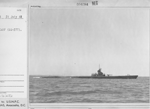 |
666k | From Brisbane, she departed on her third war patrol on 22 June 1943. She patrolled a scouting line off the Solomons and north to the Bismarck Sea. She passed the Shortland Islands on 14 July and, on the 27th, encountered an enemy convoy. Scamp (SS-277) appears here in a photo dated 21 July 1943 (which is unlikely because she was in the middle of her 3rd patrol). |
Text courtesy of DANFS. US National Archives photo # 80-G-394384 from National Archives and Records Administration (NARA), College Park, Maryland, courtesy of Sean Hert. |
|
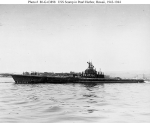 |
65k | Scamp (SS-277), in Pearl Harbor, Oahu, 1943-1944. Ford Island is in the background. | Official USN photo # 80-G-63898, from the collections of the Naval Historical Center. | |
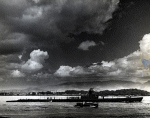 |
77k | Under a partly overcast sky, the Scamp (SS-277) arrives at Pearl Harbor, circa 1943-1944. | USN photo . | |
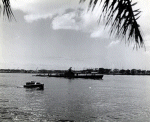 |
136k | With a small escort craft accompanying her, the Scamp (SS-277) arrives at Pearl Harbor, circa 1943-1944. | USN photo . | |
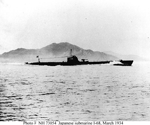 |
157k | The Kaidai Type 6A submarine HIJMS I-68 underway in March 1934, probably during her trials. This submarine was renamed I-168 in May 1942. I-168 went missing on 27 July 1943, probably torpedoed at 18.09 hrs on that day by the submarine Scamp (SS-277), 60 m off New Hanover (2 degrees 50' South, 149 degrees 01' East). | Donation of Kazutoshi Hando, 1970. U.S. Naval History and Heritage Command Photo # NH 73054 via Robert Hurst. | |
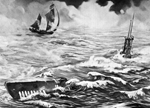 |
93k | Painting entitled Surface to Investigate by the artist E.V. Vandos, depicting Scamp (SS-277) surfacing in front of a sampan. | Photo & text courtesy of history.navy.mil. | |
 |
95k | On 12 November 1943, Scamp (SS-277) damaged light cruiser Agano so severely that the enemy warship remained in repair at Truk until the American strike of 16 and 17 February 1944. On 16 February 1944...Skate (SS-305) intercepted the Agano & fired four torpedoes for three certain hits that engulfed the ship in a shroud of smoke as the submarine submerged to evade heavy depth charging from the enemy escorts. She later returned to the scene of the attack, but before another torpedo could be launched, the cruiser rolled to port and sank. |
Photo by Takeshi Yuki scanned from "Color Paintings of Japanese Warships" courtesy of combinedfleet.com. Text courtesy of DANFS. |
|
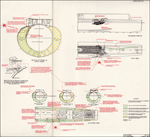 |
506k | During her seventh war patrol Scamp (SS-277) was attacked by a Japanese float plane shortly after submerging and sustained severe damage from a near-miss depth bomb detonation. The deformation which occurred to both the inner and outer hull structures as a result of this attack is the most severe known to have been survived by any U.S. submarine during World War II. It is considered remarkable that Scamp was able to continue submerged operations after receiving the damage even though all propulsion power was lost for a fifteen-minute period during which the boat became heavy overall due to flooding of the main induction system, leakage of water into the hull and loss of fuel oil from a fuel ballast tank. This report is based on the information contained in the references. The Photographs were furnished by C.O. Scamp, C.O. Tangier (AV-8) and U.S. Naval Drydocks, Hunter's Point. PLATES IX-1 and IX-2 were prepared by this Bureau and are based principally on the data contained in the enclosures to reference (d). |
Photo & text courtesy of ibiblio.org. | |
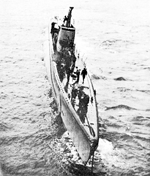 |
483k | Scamp (SS-277) coming alongside Tangier (AV-8) in Seeadler Harbor, Admiralty Islands on 19 April 1944. Original list has been reduced to approximately 5 degrees. | Source: Submarine War Damage Report No. 58; Depth Charge, Bomb, Mine Torpedo and Gunfire Damage, Including Losses in Action via Mike Green. | |
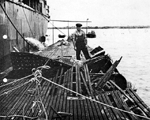 |
420k | Superstructure depth bomb damage to Scamp (SS-277) suffered on 7 April 1944 off Mindanao, Philippine Islands. The boat is tied up to the Tangier (AV-8) in Seeadler Harbor, Admiralty Islands on 19 April 1944 for temporary repairs. | Source: Submarine War Damage Report No. 58; Depth Charge, Bomb, Mine Torpedo and Gunfire Damage, Including Losses in Action via Mike Green. | |
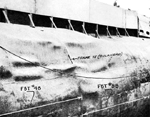 |
347k | Depth bomb damage to port side outer hull on the Scamp (SS-277) suffered on 7 April 1944 off Mindanao, Philippine Islands. The boat is docked in ARD-9 at Milne Bay, New Guinea, where she was made seaworthy to return to Hunters Point Navy Yard for a permanent repair and refit. Visible here is the temporary superstructure installed by the Tangier (AV-8). | Source: Submarine War Damage Report No. 58; Depth Charge, Bomb, Mine Torpedo and Gunfire Damage, Including Losses in Action via Mike Green. | |
 |
55k | Portside at frame 78, Scamp (SS-277), suffered severe damage from a Japanese bomb received on 7 April 1944 off of Davao Gulf while diving. Heroic damage control by skipper and crew saved life of the sub. Scamp would not be so lucky the next time in November 1944. | USN photo courtesy of Theodore Roscoe, from his book "U.S. Submarine Operations of WW II", published by USNI. | |
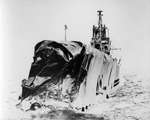 | 561k | Scamp (SS-277) collided with the destroyer Chew DD-106 during training exercises on 9 September 1944. Her records indicate that: "The entire bow superstructure for a distance of (19) nineteen feet from the bow and from the upper deck down to and including bow buoyancy tank deck, and bow buoyancy vent valve operation rod require renewal." Also, that "frames 0, A, and 1to 6 of the bow superstructure damaged," Basically, she surfaced thinking there was no one there and - crunch. Repairs were made locally at Pearl. The pressure hull was not compromised. A 20 page PDF of her 6th & 7th war patrols can be read here . | Image from the papers of RADM James W. Davis, Jr @ East Carolina University courtesy of Bill Gonyo. Photo i.d. courtesy of Robert Morgan. | |
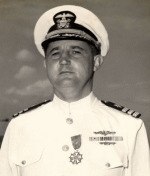 |
55k | John Christie Hollingsworth, Commander (Commanding Officer) of the Scamp (SS-277) at the time of her loss. | USN photo courtesy of oneternalpatrol.com. | |
 |
335k | Type C Escort by Takeshi Yuki, indicative of Coastal Defense Vessel No. 4, which may have participated in sinking the Scamp (SS-277). | Drawing by Takeshi Yuki scanned from "Color Paintings of Japanese Warships", courtesy of combinedfleet.com. | |
 |
59k | Google Earth satellite photo area south of Tokyo Bay, Scamp's (SS-277) last approximate position based during post-war debriefings. This position is thought to be the final resting place of the Scamp and her crew. | View courtesy of Google Earth. | |
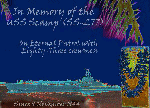 |
40k | Commemorative photo in honor of the memory of the crew of the Scamp (SS-277). | Photo courtesy of Tom Kermen. Dante's Prayer courtesy of Loreena McKennitt via loreenamckennitt.com | |
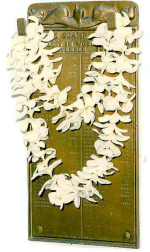 |
47k | Scamp (SS-277) memorial. | USN photo, courtesy of ussubvetsofworldwarii. | |
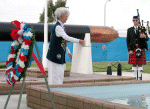 |
117k | Joyce DaSilva, the wife of Jesse DaSilva of the Tang (SS-306), one of the nine survivors of the boat, tosses a flower into a reflecting pool to honor the memory of one of the 52 submarines lost during World War II at the National Submarine Memorial-West on board Naval Weapons Station Seal Beach, Calif. On this Veterans Day, the Submarine Veterans of World War II transferred ownership of the memorial to the U.S. Navy. The following text is from The Coming Fury by Bruce Catton., pg. 478. "Major Sullivan Ballou of Rhode Island was killed in the battle, and just before it he had wrote to his wife, Sarah, to tell her that he believed he was going to be killed and to express a tremulous faith that could see a gleam of light in the dark: "But O Sarah! If the dead can come back to this earth and float unseen around those they loved, I shall always be near you in the gladdest days and in the gloomiest nights, always, always, and if there be a soft breeze upon your chest it shall be my breath, as the cool air fans your throbbing temple it shall be my spirit passing by. Sarah, do not mourn me dead; think I am gone and wait, for we shall meet again!" |
Text i.d. courtesy of Marlynn Starring. Photo i.d. courtesy of Chuck Senior, Vice Commander, Los Angeles-Pasadena Base, USSVI. USN photo # N-1159B-021 by Journalist 2nd Class Brian Brannon, courtesy of news.navy.mil. |
|
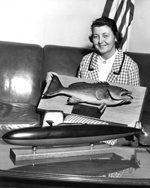 | 698k | Mrs. John C. Hollingsworth is picture with a mounted Scamp and the model of the Scamp (SSN-588) on 7 October 1960 after the rehearsal for launching of the submarine the next day. The mounted fish was a gift from the Panama City, Florida Chamber of Commerce. | Photo courtesy of Vallejo Naval and Historical Museum via Darryl L. Baker. | |
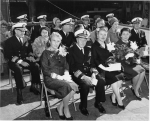 | 153k | The launching party is seated on the platform for the launching of the Scamp (SSN-588) at Mare Island Naval Shipyard on 8 October 1960. The first row on notables are from left to right: Mrs. C. A. Lockwood; Vadm C. A. Lockwood, USN (Retired); Mrs. T. S. Sutherland (Matron of Honor) She is the widow of the Executive Officer of the Scamp (SS-277). Next is Mrs. J. C. Hollingsworth (Sponsor). She is the widow of the Commanding Officer of the Scamp which was reported lost on 16 November 1944.
In Memorium: In the Second Book of Shmuel (Samuel), 22nd chapter, 5th through the 20th verses, translated from the original in Hebrew and published by the Koren Publishers of Jerusalem, Israel, 1982, can perhaps aptly describe the fate of the crew and all other U.S. submariners who died defending their county: "When the waves of death compassed me / the floods of ungodly men made me afraid; / the bonds of She'ol encircled me; / the snares of death took me by surprise; / in my distress I called upon the Lord, / and cried to my G-D: / and he heard my voice out of his temple, / and my cry entered into his ears. / Then the earth shook and trembled; /the foundations of heaven moved / and shook because of his anger /...the heavy mass of waters, and thick clouds of the skies /... And the channels of the sea appeared, / the foundations of the world were laid bare, / at the rebuking of the Lord, at the blast at the breath of his nostrils. / He sent from above, he took me; / he drew me out of many waters; / he delivered me from my strong enemy, and from those who hated me; for they were too strong for me. / They surprised me in the day of my calamity: / but the Lord was my stay / He brought me forth also into a large place: / he delivered me because he delighted in me./" | USN photo # NY9 49175-10-60, contributed by Darryl L. Baker. | |
View the Scamp (SS-277)
DANFS history entry located on the Haze Gray & Underway .
Crew Contact And Reunion Information
U.S. Navy Memorial Foundation
Fleet Reserve Association
Additional Resources and s of Interest
On Eternal Patrol
ComSubForPac Report of loss of USS SCAMP (SS 277) November 9 1944 - 83 Men Lost
Ep-21 (1) - Victory At Sea ~ Full Fathom Five - HQ
| Back To The Main Photo Index | Back To the Submarine Index |
|
Problems and site related matters, E-mail Webmaster |
|
This page is created by Gary Priolo and maintained by Michael Mohl All Pages © 1996 - 2024 NavSource History All rights reserved. |